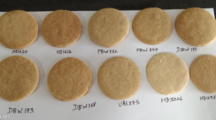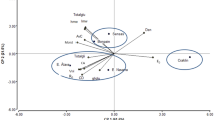Abstract
Pasta-making quality is becoming gradually important in durum wheat breeding programs. This study aimed to find out the diversity in quality traits, to investigate the pasta-making quality of 24 durum wheat genotypes for determining the promising lines and to determine relationships among quality traits by biplot and correlation analyses. Significant differences and wide variations were observed among genotypes for all quality characteristics investigated. Of the 24 genotypes evaluated, 4 genotypes resulted in good values of sensory properties, cooking loss, water absorption, and color, and could be considered as the most promising genotypes. The genotypes with higher grain protein content and gluten strength had better cooking quality of pasta. Cooking loss and water absorption were negatively correlated with sensory properties and gluten-related parameters such as glutograph stretch, gluten index, and SDS sedimentation tests. SDS sedimentation, gluten index, and glutograph are beneficial quick screening tests that can be used to improve the pasta-making quality of wheat, particularly in the early stages of breeding programs.



Similar content being viewed by others
References
Brandolini A, Lucisano M, Mariotti M, Hidalgo A (2018) A study on the quality of einkorn (Triticum monococcum L. ssp. monococcum) pasta. J Cereal Sci. https://doi.org/10.1016/j.jcs.2018.05.010
TRADE MAP (2021) Trade statistics for uncooked pasta, not stuffed or otherwise prepared, not containing egg. https://www.trademap.org. Accessed 20 May 2021
Padalino L, Mastromatteo M, Lecce L, Spinelli S, Contò F, Nobile MAD (2014) Effect of durum wheat cultivars on physico-chemical and sensory properties of spaghetti. J Sci Food Agric. https://doi.org/10.1002/jsfa.6537
Fu BX, Wang K, Dupuis B, Taylor D, Nam S (2018) Kernel vitreousness and protein content: relationship, interaction and synergistic effects on durum wheat quality. J Cereal Sci. https://doi.org/10.1016/j.jcs.2017.09.003
Hidalgo A, Brandolini A, Pompei C, Piscozzi R (2006) Carotenoids and tocols of einkorn wheat (Triticum monococcum ssp. monococcum L.). J Cereal Sci. https://doi.org/10.1016/j.jcs.2006.06.002
Ficco DBM, Mastrangelo AM, Trono D, Borrelli GM, De Vita P, Fares C, Beleggia R, Platani C, Papa R (2014) The colours of durum wheat: a review. Crop Pasture Sci. https://doi.org/10.1071/CP13293
Digesù AM, Platani C, Cattivelli L, Mangini G, Blanco A (2009) Genetic variability in yellow pigment components in cultivated and wild tetraploid wheats. J Cereal Sci. https://doi.org/10.1016/j.jcs.2009.05.002
Schulthess A, Matus I, Schwember AR (2013) Genotypic and environmental factors and their interactions determine semolina color of elite genotypes of durum wheat (Triticum turgidum L. var. durum) grown in different environments of Chile. Field Crops Res. https://doi.org/10.1016/j.fcr.2013.05.001
Groth S, Wittmann R, Longin CFH, Böhm V (2020) Influence of variety and growing location on carotenoid and vitamin E contents of 184 different durum wheat varieties (Triticum turgidum ssp. durum) in Germany. Eur Food Res Technol. https://doi.org/10.1007/s00217-020-03557-1
Sissons M (2008) Role of durum wheat composition on the quality of pasta and bread. Food 2:75–90
Deng L, Elias EM, Manthey FA (2017) Influence of durum genotype on whole wheat and traditional spaghetti qualities. Cereal Chem. https://doi.org/10.1094/CCHEM-03-17-0062-R
Sissons MJ, Egan NE, Gianibelli MC (2005) New insights into the role of gluten on durum pasta quality using reconstitution method. Cereal Chem. https://doi.org/10.1094/CC-82-0601
Kovacs MIP, Poste LM, Butler G, Woods SM, Leisle D, Noll JS, Dahlke G (1997) Durum wheat quality: comparison of chemical and rheological screening tests with sensory analysis. J Cereal Sci. https://doi.org/10.1006/jcrs.1996.0069
Branković G, Dodig D, Pajić V, Kandić V, Knežević D, Đurić N, Živanović T (2018) Genetic parameters of Triticum aestivum and Triticum durum for technological quality properties in Serbia. Zemdirbyste. https://doi.org/10.13080/z-a.2018.105.006
Mohammadi R (2019) Genotype by yield*trait biplot for genotype evaluation and trait profiles in durum wheat. Cereal Res Commun. https://doi.org/10.1556/0806.47.2019.32
AACC International (2010) Approved methods of the American Association of Cereal Chemists International, 10th edn. Minnesota
ICC (2008) Standard methods of International Association for Cereal Science and Technology. The Association, Vienna
Koksel H, Ozderen T, Olanca B, Ozay DS (2009) Effects of suni bug (Eurygaster spp.) damage on milling properties and semolina quality of durum wheats (Triticum durum L.). Cereal Chem. https://doi.org/10.1094/CCHEM-86-2-0181
D’Egidio MG, De Stefanis E, Fortini S, Galterio G, Nardi S, Sgrulletta D, Bozzini A (1982) Standardization of cooking quality analysis in macaroni and pasta products. Cereal Foods World 27:367–368
Aribas M, Kahraman K, Koksel H (2020) In vitro glycemic index, bile acid binding capacity and mineral bioavailability of spaghetti supplemented with resistant starch type 4 and wheat bran. J Funct Foods. https://doi.org/10.1016/j.jff.2020.103778
D’Egidio M, Mariani B, Nardi S, Novaro P (1993) Viscoelastograph measures and total organic matter test: suitability in evaluating textural characteristics of cooked pasta. Cereal Chem 70:67–72
Pinheiro N, Costa R, Almeida AS, Coutinho J, Gomes C, Maçãs B (2013) Durum wheat breeding in Mediterranean environments—influence of climaticvariables on quality traits. Emir J Food Agric. https://doi.org/10.9755/ejfa.v25i12.16732
Subira J, Pena RJ, Alvaro F, Ammar K, Ramdani A, Royo C (2014) Breeding progress in the pasta-making quality of durum wheat cultivars released in Italy and Spain during the 20th century. Crop Pasture Sci. https://doi.org/10.1071/CP13238
Sieber AN, Würschum T, Longin CFH (2015) Vitreosity, its stability and relationship to protein content in durum wheat. J Cereal Sci. https://doi.org/10.1016/j.jcs.2014.10.008
Turkish Food Codex (2002) Communique on pasta, Communique No: 2002/20. https://www.resmigazete.gov.tr/eskiler/2002/03/20020305.htm#10. Accessed 18 May 2021
Olanca B, Sivri Ozay D, Koksel H (2009) Effects of suni-bug (Eurygaster spp.) damage on size distribution of durum wheat (Triticum durum L.) proteins. Eur Food Res Technol. https://doi.org/10.1007/s00217-009-1116-y
Kaplan Evlice A, Pehlivan A, Sanal T, Salantur A, Kilic G, Dugan G, Boyaci IH, Koksel H (2020) Utilization potential of glutograph in wheat breeding programs and the influence of genotype and environment on bread wheat quality. Cereal Chem. https://doi.org/10.1002/cche.10279
Edwards NM, Izydorczyk MS, Dexter JE, Biliaderis CG (1993) Cooked pasta texure: comparison of dynamic viscoelastic properties to instrumental assessment of firmness. Cereal Chem 70:122–126
Yan W, Holland JB (2010) A heritability-adjusted GGE biplot for test environment evaluation. Euphytica. https://doi.org/10.1007/s10681-009-0030-5
Zaharia D, Danciu I, Codin GG, Mironeasa S, Mironeasa C (2014) Relationships of glutograph parameters with farinograph and wheat flour characteristics. J Food Agric Environ 12:33–36
Kaya Y, Akcura M (2014) Effects of genotype and environment on grain yield and quality traits in bread wheat (T. aestivum L.). Food Sci Technol. https://doi.org/10.1590/fst.2014.0041
Acknowledgements
The author would like to thank the General Directorate of Agricultural Research and Policies (TAGEM) for supporting the project numbered TAGEM/TBAD/B/18/A7/P1/286. The author also would like to thank Breeding and Genetics Department for providing the wheat samples.
Author information
Authors and Affiliations
Corresponding author
Ethics declarations
Conflict of interest
The author declares no conflict of interest.
Compliance with ethics requirements
This article does not contain any studies with human or animal subjects.
Additional information
Publisher's Note
Springer Nature remains neutral with regard to jurisdictional claims in published maps and institutional affiliations.
Rights and permissions
About this article
Cite this article
Kaplan Evlice, A. The effect of durum wheat genotypes on cooking quality of pasta. Eur Food Res Technol 248, 815–824 (2022). https://doi.org/10.1007/s00217-021-03899-4
Received:
Revised:
Accepted:
Published:
Issue Date:
DOI: https://doi.org/10.1007/s00217-021-03899-4




